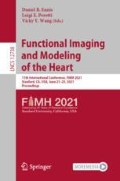Abstract
The helix orientated fibres in the ventricular wall modulate the cardiac electromechanical functions. Experimental data of the helix angle through the ventricular wall have been reported from histological and image-based methods, exhibiting large variability. It is, however, still unclear how this variability influences electrocardiographic characteristics and mechanical functions of human hearts, as characterized through computer simulations. This paper investigates the effects of the range and transmural gradient of the helix angle on electrocardiogram, pressure-volume loops, circumferential contraction, wall thickening, longitudinal shortening and twist, by using state-of-the-art computational human biventricular modelling and simulation. Five models of the helix angle are considered based on in vivo diffusion tensor magnetic resonance imaging data. We found that both electrocardiographic and mechanical biomarkers are influenced by these two factors, through the mechanism of regulating the proportion of circumferentially-orientated fibres. With the increase in this proportion, the T-wave amplitude decreases, circumferential contraction and twist increase while longitudinal shortening decreases.
Access this chapter
Tax calculation will be finalised at checkout
Purchases are for personal use only
References
Hoffman, J.I.E.: Will the real ventricular architecture please stand up? Physiol. Rep. 5, 1–13 (2017)
Sengupta, P.P., et al.: Left ventricular form and function revisited: applied translational science to cardiovascular ultrasound imaging. J. Am. Soc. Echocardiogr. 20, 539–551 (2007)
Levrero-Florencio, F., et al.: Sensitivity analysis of a strongly-coupled human-based electromechanical cardiac model: effect of mechanical parameters on physiologically relevant biomarkers. Comput. Methods Appl. Mech. Eng. 361, 112762 (2020)
Streeter, D.D., Spotnitz, H.M., Patel, D.P., Ross, J., Sonnenblick, E.H.: Fiber orientation in the canine left ventricle during diastole and systole. Circ. Res. 24, 339–347 (1969)
Anderson, R.H., Smerup, M., Sanchez-Quintana, D., Loukas, M., Lunkenheimer, P.P.: The three-dimensional arrangement of the myocytes in the ventricular walls. Clin. Anat. 22, 64–76 (2009)
Greenbaum, R.A., Ho, S.Y., Gibson, D.G., Becker, A.E., Anderson, R.H.: Left ventricular fibre architecture in man. Br. Heart J. 45, 248–263 (1981)
Stoeck, C.T., et al.: Dual-phase cardiac diffusion tensor imaging with strain correction. PLoS ONE 9, 1–12 (2014)
Toussaint, N., Stoeck, C.T., Schaeffter, T., Kozerke, S., Sermesant, M., Batchelor, P.G.: In vivo human cardiac fibre architecture estimation using shape-based diffusion tensor processing. Med. Image Anal. 17, 1243–1255 (2013)
Nielles-Vallespin, S., et al.: In vivo diffusion tensor MRI of the human heart: reproducibility of breath-hold and navigator-based approaches. Magn. Reson. Med. 70, 454–465 (2013)
Tseng, W.Y.I., Reese, T.G., Weisskoff, R.M., Brady, T.J., Wedeen, V.J.: Myocardial fiber shortening in humans: initial results of MR imaging. Radiology 216, 128–139 (2000)
Wang, V.Y., et al.: Image-based investigation of human in vivo myofibre strain. IEEE Trans. Med. Imaging. 35, 2486–2496 (2016)
Carapella, V., et al.: Quantitative study of the effect of tissue microstructure on contraction in a computational model of rat left ventricle. PLoS ONE 9, 1–12 (2014)
Holmes, J.W.: Determinants of left ventricular shape change during filling. J. Biomech. Eng. 126, 98–103 (2004)
Wang, Z.J., et al.: Human biventricular electromechanical simulations on the progression of electrocardiographic and mechanical abnormalities in post-myocardial infarction. EP Europace. 23, i143–i152 (2021)
Tomek, J., et al.: Development, calibration, and validation of a novel human ventricular myocyte model in health, disease, and drug block. Elife 8, e48890 (2019)
Land, S., Park-Holohan, S.-J., Smith, N.P., dos Remedios, C.G., Kentish, J.C., Niederer, S.A.: A model of cardiac contraction based on novel measurements of tension development in human cardiomyocytes. J. Mol. Cell. Cardiol. 106, 68–83 (2017)
Margara, F., et al.: In-silico human electro-mechanical ventricular modelling and simulation for drug-induced pro-arrhythmia and inotropic risk assessment. Prog. Biophys. Mol. Biol. 159, 58–74 (2020)
Holzapfel, G.A., Ogden, R.W.: Constitutive modelling of passive myocardium: a structurally based framework for material characterization. Philos. Trans. R. Soc. A: Math. Phys. Eng. Sci. 367, 3445–3475 (2009)
Santiago, A., et al.: Fully coupled fluid-electro-mechanical model of the human heart for supercomputers. Int. J. Numer. Methods Biomed. Eng. 34, e3140 (2018)
Gima, K., Rudy, Y.: Ionic current basis of electrocardiographic waveforms: a model study. Circ. Res. 90, 889–896 (2002)
Mincholé, A., Zacur, E., Ariga, R., Grau, V., Rodriguez, B.: MRI-based computational torso/biventricular multiscale models to investigate the impact of anatomical variability on the ECG QRS complex. Front. Physiol. 10, 1103 (2019)
Acknowledgement
This work was funded by a Wellcome Trust Fellowship in Basic Biomedical Sciences to B.R. (214290/Z/18/Z), the CompBioMed2 Centre of Excellence in Computational Biomedicine (European Commission Horizon 2020 research and innovation programme, grant agreements No. 823712). The authors gratefully acknowledge PRACE for awarding access to SuperMUC-NG at Leibniz Supercomputing Centre of the Bavarian Academy of Sciences, Germany through project ref. 2017174226 and Piz Daint at the Swiss National Supercomputing Centre, Switzerland through an ICEI-PRACE project (icp005).
Author information
Authors and Affiliations
Corresponding author
Editor information
Editors and Affiliations
Rights and permissions
Copyright information
© 2021 Springer Nature Switzerland AG
About this paper
Cite this paper
Wang, L. et al. (2021). Effects of Fibre Orientation on Electrocardiographic and Mechanical Functions in a Computational Human Biventricular Model. In: Ennis, D.B., Perotti, L.E., Wang, V.Y. (eds) Functional Imaging and Modeling of the Heart. FIMH 2021. Lecture Notes in Computer Science(), vol 12738. Springer, Cham. https://doi.org/10.1007/978-3-030-78710-3_34
Download citation
DOI: https://doi.org/10.1007/978-3-030-78710-3_34
Published:
Publisher Name: Springer, Cham
Print ISBN: 978-3-030-78709-7
Online ISBN: 978-3-030-78710-3
eBook Packages: Computer ScienceComputer Science (R0)

